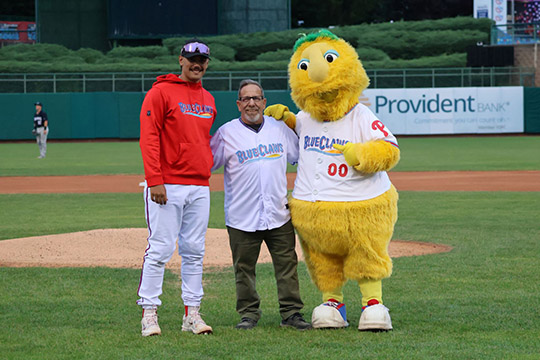“I can’t say enough about how grateful I am – I really appreciate what everyone did for me, they are amazing,”

Robert Wood Johnson University Hospital and Monmouth Medical Center Southern Campus Teams Work Together Seamlessly to Save Jerry Infurna’s Life
Chain of Survival: Jackson Father Survives Near Fatal Heart Attack Due to Rapid Life-Saving Care at RWJBarnabas Health Hospitals
When Jerry Infurna retired from his job as a union carpenter last April, he was looking forward to a new chapter in life. He started eating healthier, working out more and quit smoking. He didn’t anticipate that he would be fighting for his life only a few months later after suffering a near-fatal heart attack.
But thanks to the rapid, advanced life-saving care he received at Robert Wood Johnson University Hospital (RWJUH) and Monmouth Medical Center Southern Campus (MMCSC), both RWJBarnabas Health facilities, he is now on the road to recovery and plans to enjoy his retirement to the fullest.
Jerry first experienced chest pains while working out in the months before his heart attack. He was seeing a doctor and planned to undergo more tests but wasn’t alarmed – the pains would come and go and they were on his right side, not the left, which is more commonly associated with heart attack symptoms.
Then one Saturday morning in June, Jerry woke up with severe chest pain.
“I started having the pains around 6:30 a.m. and they wouldn’t let up, they just kept getting worse,” Jerry recalled.
He was rushed to the Emergency Department at MMCSC in Lakewood near their Jackson home. Jerry’s initial EKG didn’t indicate a heart attack, but after undergoing a CT Scan, his pain returned and doctors told him he was indeed having one. That’s the last thing he remembers from that morning. He went into full cardiac arrest and was revived by the team at MSMC before RWJBarnabas Health Life Flight transported him to RWJUH in New Brunswick. There, he was placed under the care of Ankur Sethi, MBBS, FACC, Interventional and Structural Cardiologist at RWJUH and Assistant Professor of Medicine at Rutgers Robert Wood Johnson Medical School. Dr. Sethi is also a provider with RWJBarnabas Health Medical Group.
“When I woke up (at RWJUH), I couldn’t see or speak and I panicked,” Jerry recalled. “The nurse and tech re-assured me that I was at RWJUH and it was a good place.”
When Jerry arrived at RWJUH, his heart’s ejection fraction was very low – only 20 percent, according to Dr. Sethi. Doctors needed to implant a ventricular assist device (VAD, a heart pump) to support his heart function until they could place a stent in the blocked artery to open it.
Generally, doctors will enter the leg to insert the stent. However, Jerry suffered from severe calcification and a blockage in his leg artery (Peripheral Artery Disease-PAD) so they needed to complete the procedure via external bypass. Using this method helps doctors preserve blood flow to Jerry’s leg while his heart was supported by the ventricular assist device.
According to Dr. Sethi, he used an advanced technique inside the artery called rotational atherectomy, which creates space for the stent. There was risk involved since Jerry was given clot-busting medicine when he was revived during his heart attack.
“Fortunately, the RWJUH Cardiac Catheterization lab has a team of experienced providers that routinely performs these complex procedures,” Dr. Sethi noted.
Following implantation of the VAD and the stent, Jerry’s heart function was “almost completely recovered” and he suffered no loss of neurological or cognitive function, according to Dr. Sethi.
“We will have to continue to manage and address his PAD, but Jerry should be able to have a normal life like he had before,” Dr. Sethi said.
The chain of survival played a critical role in Jerry’s outcome.
“The team at MMCSC did an excellent job responding to his cardiac arrest and stabilizing him so he could be transferred here,” Dr. Sethi noted. “Having Life Flight available to transport him here in a matter of minutes instead of hours also was an important factor.”
Ironically, Jerry’s family had a previous connection to RWJUH. Both Jerry and his son, Alexander, are avid motocross bikers. Alexander raced competitively for many years before he had a serious accident at Englishtown in 2016 and was rushed to the Level I Trauma Center at RWJUH, where doctors saved his life.
Each day at RWJUH, Jerry re-gained his strength and began to feel better. He encourages others to call the doctor immediately if they notice something doesn’t feel right.
“My pain was on my right side not my left side, but I would also feel pain in the back of my neck and in the middle of my shoulder blades,” Jerry recalled. “If something doesn’t feel right, you have to call the doctor right away.”
Now that he is feeling better, Jerry plans to continue working out, eating healthy and following his doctors’ orders. He can’t wait to ride his motocross bike again and go camping with his wife and friends.
He is deeply grateful to the teams at RWJUH and MMCSC who worked together seamlessly to save his life.
“I can’t say enough about how grateful I am – I really appreciate what everyone did for me, they are amazing,” Jerry said.